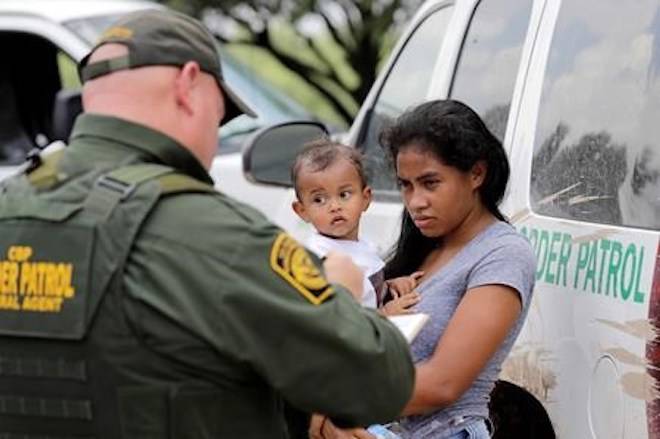The children at the centre of the national debate over President Donald Trump’s immigration policy have been heard about but rarely seen.
News organizations say they are pushing back every day against Trump administration restrictions on access to facilities where children separated from their parents are being held. Government handouts satisfy few, and there have been disputes raised in some of the few independent instances where a sense emerges of what is happening at the border.
“It’s not enough for the government to provide curated images,” said Noah Oppenheim, NBC News president. “The public expects and demands and has the right to see a verified picture of what is going on inside these detention centres and how this policy is being carried out in their name.”
After reporters were allowed to tour one Texas facility without cameras, the administration objected to descriptions of fenced-in enclosures as cages. A still photograph of a crying Honduran toddler whose mother was stopped crossing into the United States became a symbol to many of the since-reversed separation policy, in large part because other images were limited. The government revealed Friday that the girl and her mother were being held together.
Calls for access collide with a longstanding tradition of not allowing photographs of children in government care that the feds have applied to the immigrant children. The federal Health and Human Services department cites a 2015 policy that predates Trump’s presidency in prohibiting cameras, interviews with children or tours without two weeks’ notice. Their age leaves the children vulnerable to abuse, HHS said.
If the government wants to negotiate, there are ways to set ground rules to protect the interests of both sides. For instance, journalists are often embedded with military forces with the promise they won’t reveal strategy or troop movements that could put people at risk. CBS News is willing to negotiate, although standards editor Al Ortiz said Monday that CBS ran a story that showed some immigrant children being transported outside of campgrounds with some faces visible.
“Otherwise, we’d have a faceless story,” Ortiz said.
Related: New GOP plan: Hold kids longer at border – but with parents
Related: In reversal, Trump signs executive order to stop family separation
From the administration’s standpoint, the rule lowers the heat, communications experts say. Audio obtained by ProPublica of crying children at a federal facility was influential before Trump changed his policy — even though there were no visuals.
“In general, your goal is to demystify things, because every imagination could run wild if you allow it to,” said Joel Johnson, who worked in the Clinton White House and Capitol Hill and is now managing director of the Glover Park Group, which includes crisis counselling. “The fundamental question is whether what’s behind the curtain is worse than people imagine. If that’s the case, you don’t let people behind the curtain.”
Government communications officials want to control the message, and “sticking a camera in the face of toddlers is not a way to control the message,” said Erin Pelton, who worked at the White House and United Nations and is now managing director of the Washington firm Mercury.
On Monday, HHS officials led reporters on a tour of a government-run tent city for children in Tornillo, Texas on Monday. MSNBC pictures showed the tents behind large fences with no faces visible. The network ran government-provided video showing some of the accommodations, labeling it as such.
Mark Weber, top spokesman for the agency, said on Fox News Channel that it was an opportunity to let the public know the children are being taken care of.
“We’re not going to let them die in the desert,” he said.
HHS has released a series of similar photos and videos from various facilities. There are images of stacked-up laptops, beds with stuffed animals on the pillow, pictures of superheroes on the wall, breakfasts with scrambled eggs and cereal. Children are seen in neat lines and in what looks like government-issued clothing, but no faces are seen. Children are seen playing soccer, for instance, but camera shots are from the back or focused on the waist down.
Television network have shown some of the government-provided video in limited amounts, but labeled to let viewers know that the material was not gathered independently. Executives say they use the information reluctantly but that otherwise viewers would have no idea what is happening inside.
“If you tell the viewer, ‘This is from the government,’ I think the viewer is smart enough to say, ‘I wonder what else is there and I wonder what we haven’t seen,’” said Libby Leist, executive producer of NBC’s “Today” show.
The Associated Press has a policy of not distributing handout video without other elements in the story, given the sanitized portrayal provided by the government, said spokeswoman Lauren Easton. Because of newsworthiness, some government-issued still pictures were sent by the AP, the source made clear to users of the service.
The New York Times does not use the government-provided images because independent news photographers were not allowed in. While the newspaper has in the past used some handouts if they are newsworthy — the picture of former President Barack Obama and his aides waiting to see if the raid that killed Osama bin Laden was successful, for example — it does not want to set a precedent.
CBS’ Ortiz said the handouts also raise questions, noting that the children seen are boys. “There are no pictures of girls,” he said. “Where are they?”
Because of the restrictions, journalists are working harder than ever to find other material, like ProPublica did with its audio. Johnson believes the strategy of withholding access is doomed to fail.
Pelton agreed. “It’s inevitable that we will see more of what is happening and the more we see of the images, the more disturbing it will be for the audience,” she said.
David Bauder, The Associated Press



